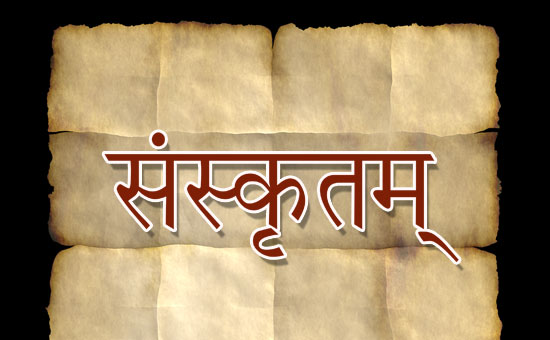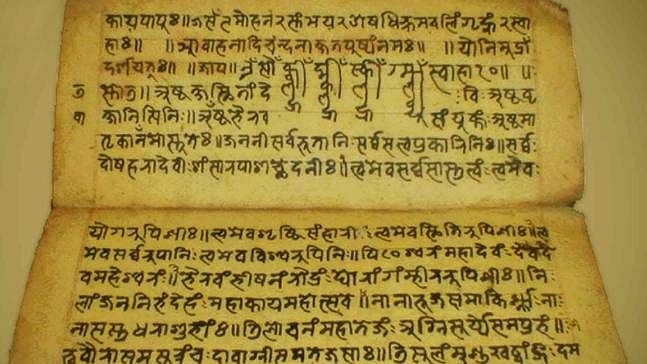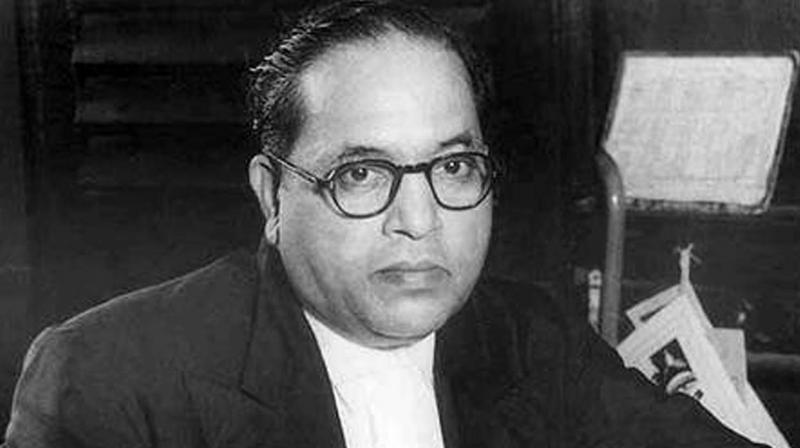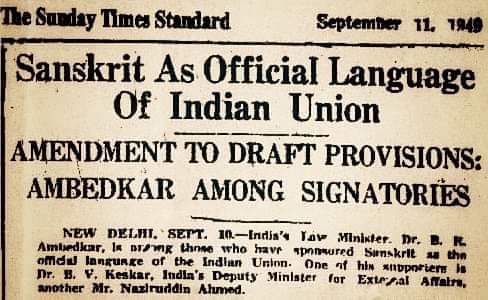
- Samskritam has been a significant influence in shaping our identity as a country.
- The very fact that our motto is the Samskrit- derived maxim “Satyameva Jayate” makes it evident.
- A stereotype exists that Samskritam is only a language for chanting mantras on occasions.
- A huge segment of the Samskrit literature deals with science, mathematics, tarkashastra, law, philosophy, and many more things.
- Dr Ambedkar had proposed that Samskritam be our National language.
- Dr Ambedkar had foreseen that, in the future, linguistic fights may occur in this diverse environment and the best Indian language that could prevent these had to be Samskritam.
- Samskritam is still a prominent, nation uniting language and can be the common language connecting people across the country.
- On this auspicious occasion of Ambedkar Jayanti, it’s important for us to know and acknowledge the efforts made by Dr Ambedkar in reviving the identity, the culture, and Samskritam.
Identity
Identity is a testimony to existence. It justifies our very existence, the very astitvam. It defines what we are. Interestingly, identity may not be necessarily of a person; everything that exists has its own identity, may it be a person, an animal, a group, a region, etc.
Similarly, a country too, has its own identity, a national identity. It’s the sense of an integrated nation, as depicted by its distinctive cultures, languages, ideas, belief and traditions. It’s the basic character of a country that has evolved over a period of time as a result of various events witnessed throughout the years of its existence. Such an identity is based largely on the culture and language of the land.
Our Identity
India too, has its own identity. We identify ourselves with the very concept of “Unity in Diversity”, and rightly so. India is such a vast demographic space and has been home to multiple cultures and traditions since years, all living in harmony with one another, under a same national identity.
It wouldn’t be an overstatement to tell that the language of Samskritam has been a significant influence in shaping our identity as a country. The very fact that our motto is the Samskrit- derived maxim “Satyameva Jayate” makes it evident. The reason I call it significant is because this language and the culture it brought along, being the most ancient, have witnessed this country and its growth for the longest time.
Another reason why I’d like to categorise Samskritam as “significant” is because of the culture, the knowledge the language carries along with it. There is a reason why it is called the “Devavaani”, the language of the Gods. The very grammar of this language is perfectly and scientifically developed, ranging from the basic grouping of alphabets in a systematic order to complex Chandas shastra. It is the language where even poetry maintains a discipline and yet carries its essence, the language where shlokas aren’t just religious or spiritual, but also carry extensive amount of knowledge. Amazing indeed!
It is the language that had been the medium of conversation, instruction and preserving information for the Rishis – not just sages, but the ancient scientists. A stereotype exists that Samskritam is only a language for chanting mantras on occasions. However, in reality, Samskritam is far beyond this stereotype. A huge segment of the Samskrit literature deals with science, mathematics, tarkashastra, law, philosophy, and many more things. That explains why we have renowned scholars in all the fields. Charaka and Sushruta in medical sciences; Bharatamuni in Natya shastra; Patanjali in Yoga; Bharati Krishna Tirtha in Vedic mathematics; Varahamihira, Aryabhatta and Bhaskaracharya in mathematics and astronomy; Kalidasa, Shudraka, Bhaasa and many more in literature, just to mention a few. Samskritam, as discovered by NASA, is the most suitable language to develop computer programming for their Artificial Intelligence program. That proves that Samskritam is not just an ancient language, but also has a lot in store for the future as well!
We also witnessed multiple schools of thoughts, ideologies evolve through Gurus and how all these different ideologies co-exist in harmony and respect. Samskritam gifted us the culture of “accepting” rather than merely “tolerating” new people, new ideas, new cultures. That created the foundation for ‘co-existence in diversity with ease’.
This leads us to a very important question – this language that shaped the identity of our country, the one that provided a platform to such scholars – where is it today?
Identity Crisis?

As stated earlier, identity evolves over a period of time affected by the events and changes occurring throughout the journey. Our country too, came across such multiple unpleasant events that severely affected our basic identity and existence. Those unpleasant events were indeed the foreign invasions. Our country majorly suffered from 2 invasions – the Islamic and the British. Both of these affected Samskritam through different ways.
First came the Islamic invasion. Their approach towards attack on our culture was more of physical violence, destruction and aggression. They believed in ruling us by making us fear them. That’s the reason there were temples, ashrams and libraries destroyed and burnt down. They broke our places of knowledge and faith. The very infamous destruction of the Nalanda and Vikramshila universities by Bakhtiyar Khilji is a prime example of their violence.
Then came the British invasion. Theirs was quite a different approach. They kept their greedy ambitions behind the façade of trade. They slowly grew, crept into the administrative, set our people up against one another and started to sow the seeds of ‘divide and rule’. That plan though, much to our misfortune, worked wonders for them. They knew that our identity, our power lies in our knowledge, our culture, our traditions. They led an attack on our very strength. They created a false narrative of our history and also convinced us to believe it. They changed the identity of the Vedas calling them “religious texts” when in fact, the Vedas were a powerhouse of knowledge. Similarly, our “Epics” like Ramayana and Mahabharata were classified as “Mythology”, “Varnas” became “Caste”, “Rishis” became just “Saints”, and the problems began. Their systematic attack on our history and our minds succeeded as our people believed in their propaganda that we were an inferior race and should be accepting their overlordship.
These events caused us to break links with our glorious history. While the Islamic invasion led to the destruction of our libraries, art work and manuscripts, the British made sure our language and our culture get farther from us. This brought us to the brink of a far more dangerous issue – a problem almost every colonial country suffered from – identity crisis.
Identity Revival
“Not all superheroes wear capes”, they say. Well said.
In those testing times, fighting for our existence, our identity, our pride, this country found many superheroes in disguise of freedom fighters. Few leaders and kings fought with arms and ammunitions, the revolutionaries fought with their ideological weapons, Gandhiji fought in his unique Ahimsa way, and many more laid down their lives for the country.

When the inevitable victory for this war was in sight, few more superheroes started to prepare the country for the post-independence era. They envisioned the country’s future, how would it be, how would it function, etc. This group of visionaries was led by the pioneer of the Indian Constitution, Dr B R Ambedkar. On this auspicious occasion of Ambedkar Jayanti, it’s important for us to know and acknowledge the efforts made by Dr Ambedkar in reviving the identity, the culture, and Samskritam.
Dr Ambedkar had himself studied Samskritam and he strongly believed that Samskritam should be the official language of the Independent India. Dr Ambedkar, in the Constitution Assembly meeting held on September 10, 1949 (as recorded by The Sunday Hindustan Standard on 11th September, 1949), had proposed that Samskritam be our National language. He had strong, rational and valid reasons backing this thought too. He had foreseen that, in the future, linguistic fights may occur in this diverse environment and the best Indian language that could prevent these had to be Samskritam.
Another reason was that, by then, owing to the British ‘divide and rule’, the caste system and lower caste oppression had become a new social evil, of which Dr Ambedkar himself had been a victim. Also, Samskritam was started to be labelled as “Brahmins’ language”. Dr Ambedkar believed that if Samskritam was made the National language, that would reduce to a great extent, this social injustice. Also, he believed that Samskritam would work as the link between us and our glorious history, thereby not letting us fall prey to the distorted history of India portrayed by the British.

Dr Ambedkar had also requested the Akhila Bharatiya Harijan Sangh to support his proposal of Samskritam being made the national language. However, few volunteers led by Sri B P Maurya raised severe objections resulting in Dr Ambedkar withdrawing his request. Years later, Sri B P Maurya regrets his opposition in his letter to NCERT dated February 14, 2001; stating as a result of his inexperience, he opposed Babasaheb Ambedkar’s proposal.
Not just that, even the other national leaders including Gandhiji, Dr Rajendra Prasad, Dr S Radhakrishna have emphasized how important Samskritam is to truly get an understanding of India and its culture, how it impacts and enhances an individual’s abilities, how beautiful and perfect the language is, and is indeed a national treasure to be protected. Gandhiji even went ahead to suggest his children to learn Samskritam (as mentioned in his letter to Harilal Gandhi in March 1913).
The unfortunate truth, however, is that this dream of Babasaheb is still waiting to be fulfilled.
Samskritam today
Even though Samskritam couldn’t be the national language, it is very much alive and flourishing today, unlike the claims made by a few people calling it a ‘dead language’. It could only be possible because of persistent efforts of ardent Samskrita enthusiasts and well-wishers, people who kept the language and its spirit alive. Many NPOs made the promotion of Samskritam their sole purpose and worked towards making it the people’s language once again.
Significantly, a people’s Samskrit movement started in the early 80s by an NPO named ‘Samskrita Bharati’ where ‘Samskrita Sambhashana’ (conversation in Samskritam) has been the main vision, and they’ve been successful in turning it into a global movement, spreading across 21 countries. Thanks to these efforts, the Government too, did recognise Samskritam; may it be through the inclusion in the list of languages for Sahitya Academy, or the inclusion in the Eighth Schedule of the Indian Constitution, and many more. Our country has witnessed the creation of 5 Samskrit graamas(villages) and lakhs of people conversing in Samskritam as at present.
What Next?
Though not the National language today, Samskritam is still necessary as a prominent, nation uniting language. It is also very much possible – history has witnessed revival of several languages and cultures. Israel is the living example of this astounding feat. Indonesia, another country with a huge diversity, having hundreds of indigenous local languages, has Bahasa Indonesia as its official language connecting the whole country together. We too, can accept and implement Samskritam as the common language connecting people across the country, unleash its full potential, get inspired by the glorious past, and march forward towards a bright future.
It’s the right time we wake up, learn, understand and acknowledge the beauty of Samskritam, start our journey from making it a part of our conversations and growing to making it the medium of our conversations. Let’s join hands with the people working for the rejuvenation of Samskritam. Fortunately, with the whole elementary schooling system in India revamping itself for the better through the new National Education Policy, we may make our wholehearted efforts in bringing in Samskritam as a language to learn for the smaller citizens, the future of our country, not merely as a ‘marks-scoring’ subject, but as a medium of conversation. Let’s wish and work towards fulfilling the meaningful dreams Babasaheb Ambedkar envisioned for India, the proud identity he dreamt for India.
Samkrit Enthusiast and Volunteer for Samskrita Bharati

Excellent article covering complete background and next steps. Thank you!
Very good decission of Dr. B R Ambedkar.. I’ll give for a big salute to him. Vande Bharat Mataram.
Amazing article – enlightening on various aspects
Thank u for exchanging these rare information of sanskrit
Thank you Sripad for such an amazing article it’s good to know about India and our Indian culture and language importance.